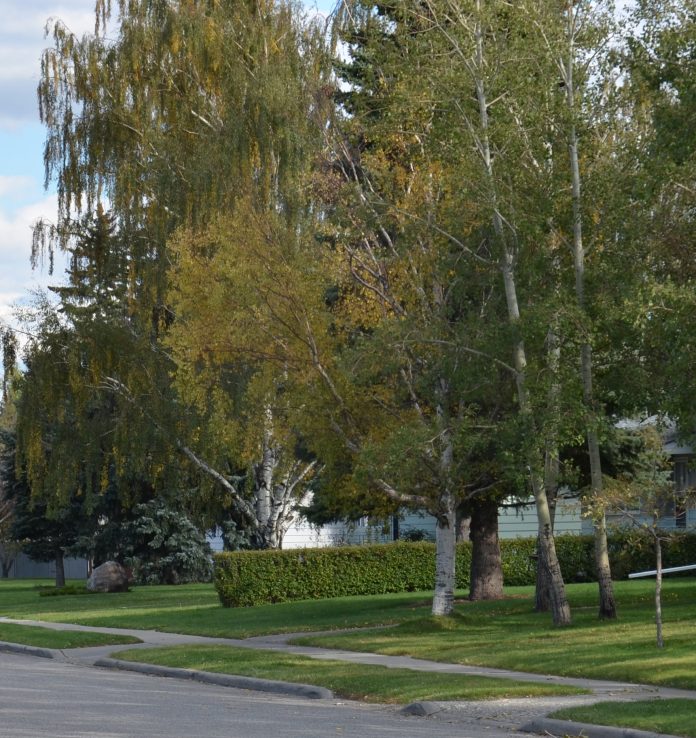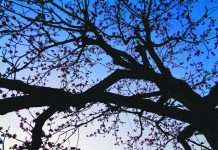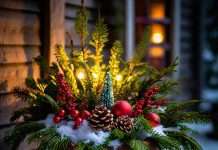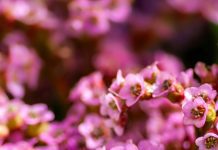Article and photograph by Monika Smith
Calgary is fortunate with its many trees and a luxuriant canopy in what was a short grass prairie. As Calgary is hitting 150 years, many planted trees are now mature, and some are at risk of aging out.
Spruces and boulevard trees can easily hit 100, but depending on the species, 40 to 200 can be the life span. For those of you who have planted limber pines (Pinus flexilis), they can live over a thousand years, bristlecone pines (Pinus aristata) even longer. Some very old trees are in Edworthy Park. Rocky Mountain Douglas fir (Pseudotsuga menziesii var. glauca) grows along the Douglas Fir Trail; some are at least 500 years old. Along the Bow and Elbow rivers, trees grew well and evolved with our fussy weather and climate. It takes a special tree species to deal with everything that Calgary can throw at it: heat, cold, wind, hail, and the conquering combo of a Chinook. What grows well? Balsam poplars (Populus balsamifera) and trembling aspens (Populus tremuloides), common across North America, thrive here. We also have two conifers found on the south shore of our rivers where snow stays and protects them: the Rocky Mountain Douglas fir and the white spruce (Pica glauca).
But we have trees that are aging out and Calgary is going through drought.
We are facing a double whammy for our weeping birches. This is not a long-lived species to begin with and some trees, like mine, were losing canopy and small branches; they live about 40 to 50 years in Calgary. But they are also a water-loving tree.
If the tops of the trees stop producing leaves and looks dead? It won’t take long to die, progressing rapidly from top to bottom. I made the difficult decision, in consultation with an arborist, to take my weeping birch down. For decades, that tree has been a constant joy. A place for birds and squirrels to romp around in, and gorgeous golden fall colour. And what a wonderful shade tree! I will miss it.
But other trees were also having problems. One of my crabapples (Malus spp) had a tough time: bark falling off, branches chocking the interior from poor air and light circulation. Crabapples are thriftier than birches, but only live 40 to 60 years. Sadly, this tree with its pink spring beauty is gone. A lot of birds have lost a place to roost, feed, and shelter. One badly sited tree, an apricot, was dying, and an unknown fungus was slowly breaking it down, doing an important job recycling.
I’m looking at shrubs to take their place. There’s now space to replant and a lot more water in the soil ready to be taken up again. My delightful native pin cherry (Prunus pensylvanica) is a multi-stemmed species and about three meters tall. It is a decent size, offers some shade and flowers, and birds have a mother tree to live off. Maybe another one? Native trees and shrubs can handle prairie dryness and clay soils, plus the foothills’ see-saw weather: chinooks, hail, cloudbursts, deep cold, wind gusts, no snow to snowmageddons, and heat.
Water restrictions are here. The Bow Basin has 12 water shortage advisories as of December 2023. The City of Calgary’s recommendation is to water most species to the roots one or two times a month during the growing season (April to September) and increase to once a week during hot weather. Use about 38 litres per inch of trunk diameter (at 54-inches above grade). The bigger the tree, the more water! You will pay for that water!
Keep an eye on your trees this summer, especially those older ones that just might be senescing. They’ll need help this coming summer. Water well but thoughtfully. Harvest your rainwater and keep the water in the ground through good mulching.
Think about what makes a wonderful community and how to keep trees healthy! Look at native trees and shrubs that have adapted to drought conditions.










